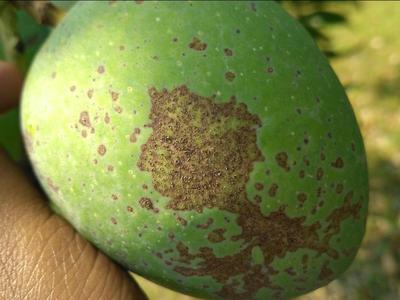Mango Scab
Elsinoë mangiferae
Fungus
In a Nutshell
- Formation of small black lesions on fruit.
- Infected stem looks slightly swollen with grey lesions.
- Brown spots with light halo on leaves.
Can also be found in
Symptoms
The symptoms are caused by the fungus of Elsinoë mangiferae. Symptoms may vary depending on various factors such as the variety, plant part, age of tissue at the time of infection, plant vigor and lushness. Small black lesions appear on young fruits. Round or irregular brown to grey lesions are formed on leaves as the infection intensifies. The leaves become crinkled, deformed and defoliation occurs. The lesions develop into light-brown scabs or scarred tissue. Severely affected fruits may drop prematurely whereas the fruits remaining on the tree develop scar tissues, which render the fruit unmarketable. Slightly raised grey colored, oval to elliptical lesions will occur on the stem tissue. Large, light-tan, corky areas have also been observed on stems. In rare cases, lesions will occur on the leaves. Brown spots with halos appear and the leaves' edges will also develop lesions. Corky lesions on the lower surfaces of leaves are also observed. Defoliation can occur under severe infections.
Recommendations

Organic Control
As of today, no biocontrol methods have been developed against this fungi. However, fungicides containing copper can be used for the treatment of the infected plant parts.

Chemical Control
Always consider an integrated approach with preventive measures together with biological treatments, if available. Apply copper fungicides of oxychloride and hydroxide or oxide from at least flower bud emergence stage to flowering at two to three-week intervals. Replace copper sprays with mancozeb during flowering and fruit set. As wet conditions favor the fungal infection, more frequent applications of the fungicide are needed. This can also compensate for the wash-off and increase the effectiveness of the treatment.
What caused it?
Mango scab appears in swampy low-lying orchards. Prolonged rain at flowering and early fruit set stages can lead to its appearance. Only young tissue is susceptible to infection and fruit is resistant to infection once it reaches about half size. It can only survive on living plant tissues. The fungal spores can be spread through rain splash or wind, causing a secondary infection. Otherwise, it survives in the soil debris. The symptoms can be confused with those of Anthracnose, except the raised structures in these scab lesions in contrast to the non-raised lesions of Anthracnose.
Preventive Measures
- In severely affected trees, it is beneficial to prune away old infected stems to reduce the levels of inoculum.
- To prevent infection and disease spread, remove and destroy the dead tissues that can survive in soil material.
- As the spores can easily spread by rain splash, it is advisable to prune deceased inflorescences, dead branches and mummified fruit to reduce its spreading.



